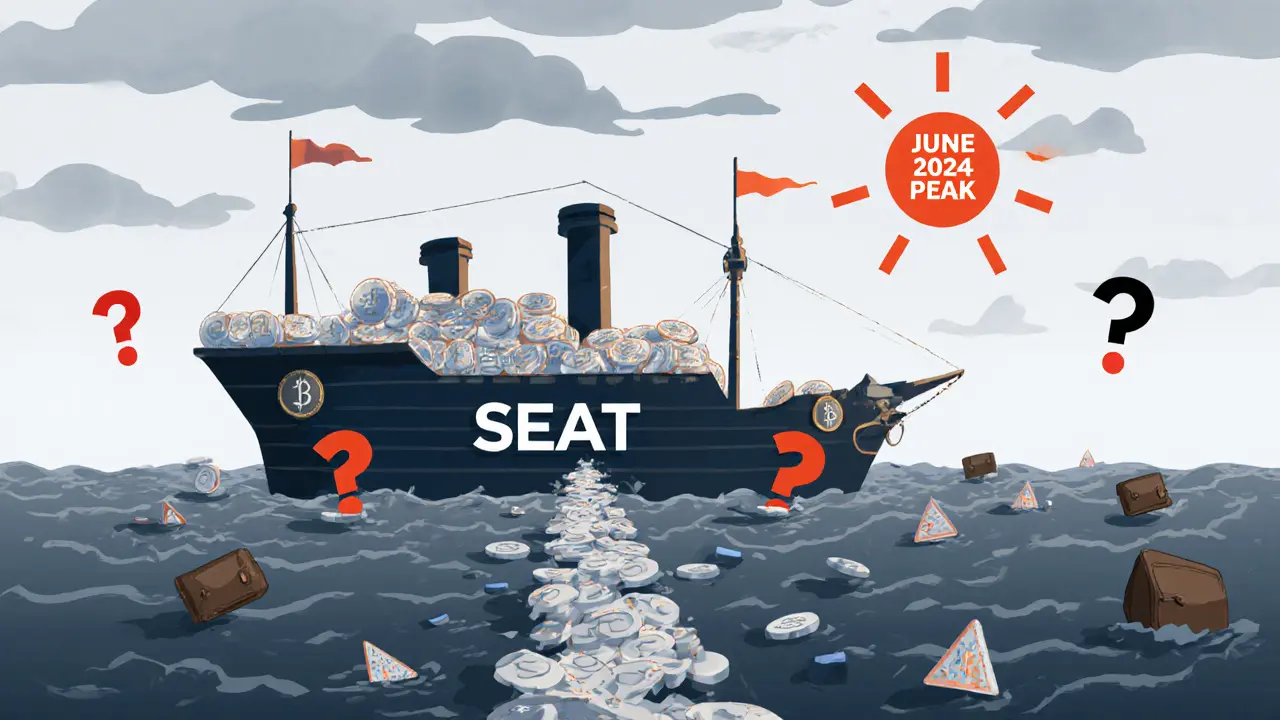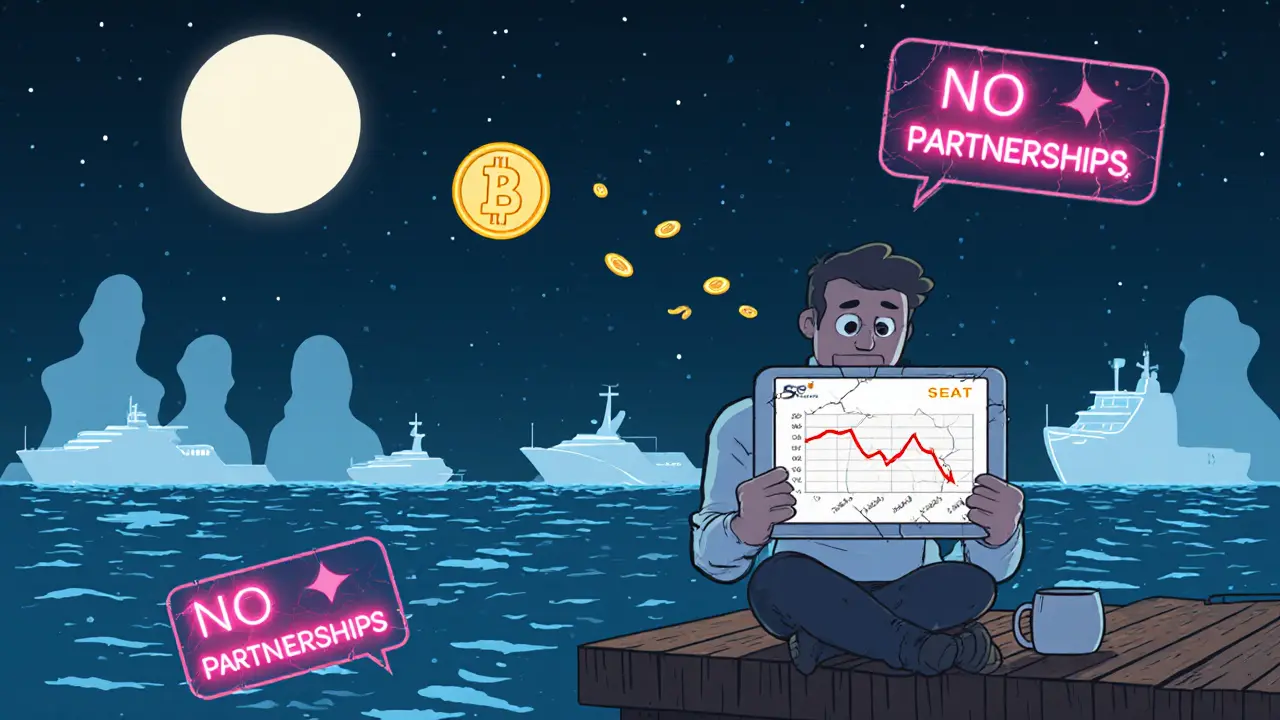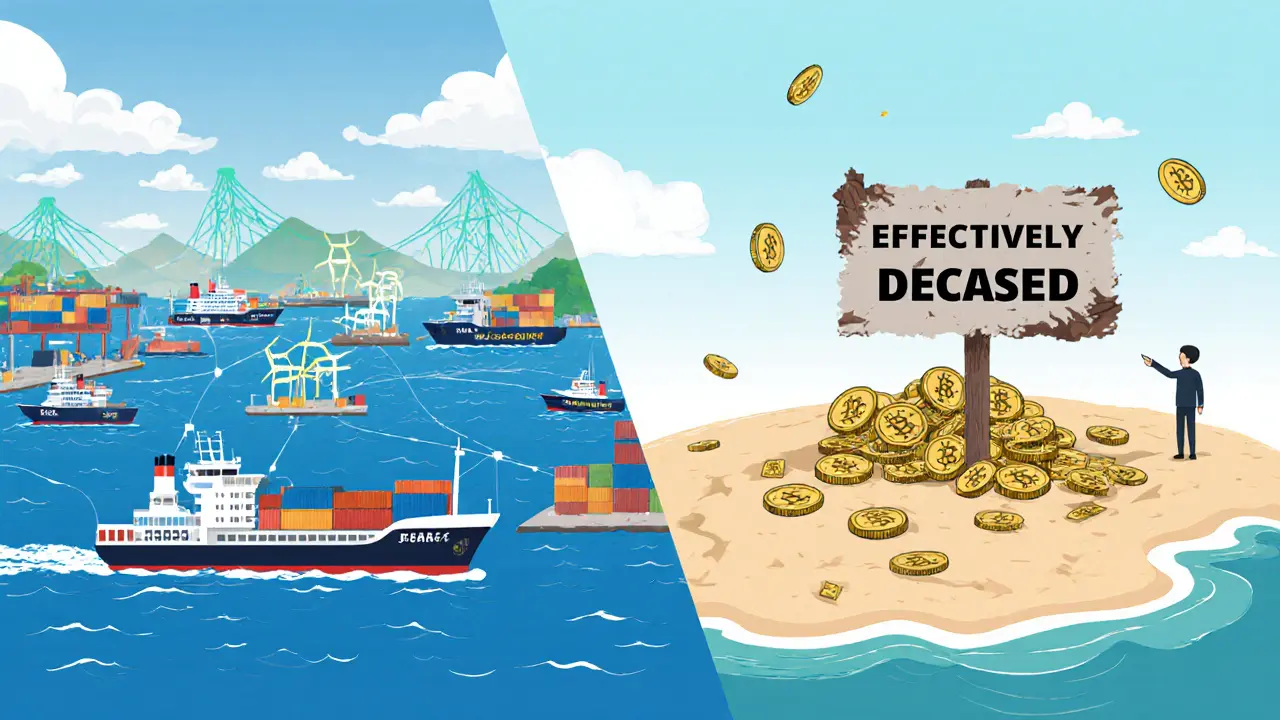
SEAT Token Loss Calculator
Investment Loss Calculator
Calculate how much you would have lost if you invested in Seamans Token (SEAT) at its peak price.
Seamans Token (SEAT) was launched in 2024 with a bold promise: to become the digital currency of the global maritime industry. It claimed to power everything from yacht rentals and vessel sales to eco-friendly shipping incentives. At its peak in June 2024, SEAT hit $27.24. Today, it trades at around $0.0001346 - a drop of over 99.999%. That’s not a correction. That’s a collapse.
What Seamans Token claims to do
The project says SEAT is built for the ocean economy. Its website and whitepaper talk about a platform where you can buy used ships, rent yachts, trade seafood, and even earn tokens for cleaning up marine debris. It’s supposed to be an ERC-20 token on the Polygon blockchain, with a fixed supply of 5 billion coins. All of them are already in circulation. The idea sounds useful - if it were real.The problem isn’t the concept. The maritime industry is worth over $3 trillion. Blockchain could help track cargo, reduce fraud, and cut paperwork. But SEAT doesn’t do any of that. There are no verified partnerships with shipping companies, ports, or marine logistics firms. No real businesses accept SEAT for payments. No case studies. No pilot programs. Just a website and a token.
The price crash that tells the whole story
SEAT’s price history is textbook pump-and-dump. In June 2024, it soared to $27.24. That’s not because of adoption. It’s because of hype, social media bots, and low-volume exchanges. By October 2025, it had crashed to $0.0001346. That’s not a market correction. That’s what happens when a project has no utility, no team updates, and no transparency.Trading volume tells the same story. On Gate.io - the only exchange where SEAT is listed - daily volume hovers around $140,500. Compare that to Bitcoin’s $20 billion or even a mid-tier crypto like Polygon’s MATIC at $300 million. SEAT’s volume is less than 0.05% of what’s needed to be considered liquid. That means if you try to sell more than a few thousand tokens, you’ll crash the price.
No real users, no real adoption
There are 4,520 token holders, according to CoinMarketCap. That’s not a community. That’s a group of speculators who bought at the top and are now stuck. Reddit threads ask, “What happened to Seamans Token?” The answers are all the same: “No updates since 2024.” “No GitHub repo.” “No team members named.” “Looks like a rug pull.”Twitter hasn’t seen a post from the official @SeamansTec account since June 2024. Trustpilot has zero reviews. The project’s website has a basic FAQ and nothing else. No support email. No live chat. No roadmap progress. The only thing moving is the price chart - and it’s going straight down.

Why it’s not a legitimate utility token
True utility tokens solve real problems. Power Ledger helps households trade solar energy. Travala lets you book hotels with crypto. Both have partnerships, real users, and steady adoption. SEAT has none of that.It claims to reward marine conservation, but there’s no way to prove who’s earning tokens for cleaning oceans. It says it enables vessel trading, but no ship broker uses it. It promises B2B transactions, but no maritime company lists SEAT as a payment option. Without these, it’s not a currency - it’s a gambling chip.
Blockchain security firms like CertiK have flagged similar tokens as high-risk. When a coin drops 99.999% from its peak and has zero real-world use, it’s not a project failing - it’s a scam waiting to be exposed.
Where you can trade SEAT - and why you shouldn’t
SEAT is only listed on Gate.io and a few tiny decentralized exchanges. You can’t buy it on Binance, Coinbase, or Kraken. To trade it, you need a Polygon-compatible wallet like MetaMask, and you have to navigate decentralized exchanges - which is already complex for most people.Even if you buy SEAT, you can’t spend it. You can’t convert it to cash easily. And if you try to sell, you’ll likely be the last person holding it. The liquidity is so thin that even small sell orders can trigger a 10-20% drop in price within minutes.
How it compares to other industry-specific cryptos
There are other crypto projects targeting specific industries. Power Ledger (energy), Filecoin (storage), and Ocean Protocol (data) all have real teams, working products, and millions in market cap. SEAT’s $673,000 market cap is smaller than many meme coins. It ranks #7,826 on CoinMarketCap - below hundreds of tokens with no real purpose at all.Unlike these projects, SEAT doesn’t have a public development team, no code repository, no audits, and no technical documentation. It doesn’t even have a clear roadmap with deadlines. It’s all promises and no progress.

What experts and analysts say
Crypto analysts at CoinGecko and BeInCrypto describe SEAT as “focused on marine leisure culture” - a polite way of saying it’s a niche meme with no substance. BeInCrypto’s technical analysis shows a bearish trend: the 50-day moving average is below the 200-day, a classic sign of long-term decline.Industry reports from Messari and Blockspot.io call SEAT “effectively deceased.” That’s not an opinion - it’s a data-driven conclusion. No trading volume. No developer activity. No partnerships. No updates. Just a dead token on a chart.
What you should do if you own SEAT
If you bought SEAT at $27, you’re not alone. Thousands did. But holding it won’t bring it back. There’s no recovery plan. No rescue team. No announcement coming. The only thing left is whether you want to cut your losses or keep hoping for a miracle that won’t happen.There’s no value in waiting. The token has no utility. No demand. No future. If you still hold it, consider selling - even at a tiny fraction of what you paid. It’s better than losing everything when the last exchange delists it.
Final verdict: Is Seamans Token worth anything?
No. Seamans Token (SEAT) is not a cryptocurrency. It’s a failed experiment, possibly a scam. It promised to revolutionize maritime trade but delivered nothing but a price chart that collapsed faster than any legitimate project ever could.There’s no evidence it’s used by a single shipping company, port authority, or marine business. There’s no team, no code, no updates. Only a ghost of a token trading on a low-volume exchange, held by people who don’t know any better.
If you’re looking for crypto that solves real problems in shipping or logistics, look elsewhere. Projects like TradeLens (by Maersk and IBM) use blockchain - but not as a currency. They use it for tracking. That’s the future. SEAT is just a footnote in crypto history.
Is Seamans Token (SEAT) a real cryptocurrency with utility?
No. Despite claims of powering maritime transactions, SEAT has zero real-world adoption. No shipping companies, ports, or marine businesses accept it. There are no verified partnerships, no functional platform, and no evidence of its use beyond speculative trading.
Why did SEAT’s price crash so hard?
SEAT’s price crashed because it was driven by hype, not utility. It peaked at $27.24 in June 2024 due to pump-and-dump activity. With no real users, no team updates, and no liquidity, the price collapsed to under $0.00014 by October 2025 - a drop of over 99.999%. This pattern is typical of tokens with no underlying value.
Can I use SEAT to buy ships or yacht rentals?
No. There are no documented cases of SEAT being used for any maritime transaction. The platform that was supposed to enable vessel sales, yacht rentals, or marine product purchases has never launched. All claims remain theoretical.
Where can I trade Seamans Token?
SEAT is only listed on Gate.io and a few small decentralized exchanges. It is not available on major platforms like Binance, Coinbase, or Kraken. Trading volume is extremely low, making it difficult to buy or sell without causing large price swings.
Is SEAT a good investment?
No. SEAT has no future prospects. It has no development activity, no community support, and no path to recovery. Experts classify it as “effectively deceased.” Holding it risks losing your entire investment when the last exchange delists it. It is not an investment - it’s speculation on a dead project.
Are there any legitimate alternatives to SEAT for maritime industry crypto?
There are no direct crypto alternatives to SEAT, because SEAT has no real utility to copy. However, blockchain solutions like Maersk’s TradeLens (built on IBM’s platform) are being used successfully to track shipping containers and reduce paperwork. These are enterprise-grade, non-crypto blockchain systems - not speculative tokens.
Leave a comments